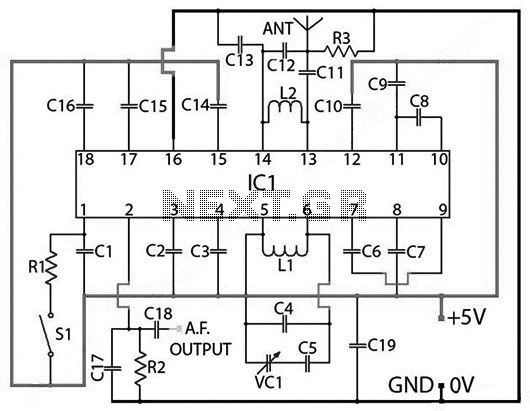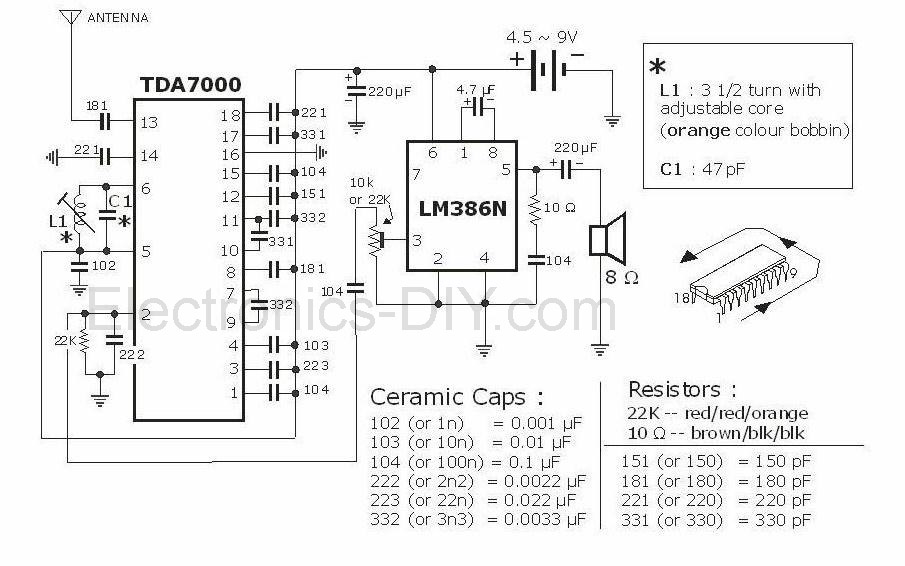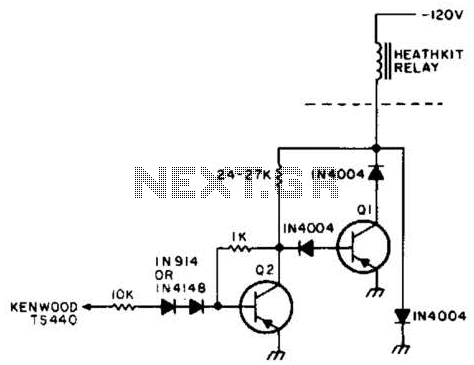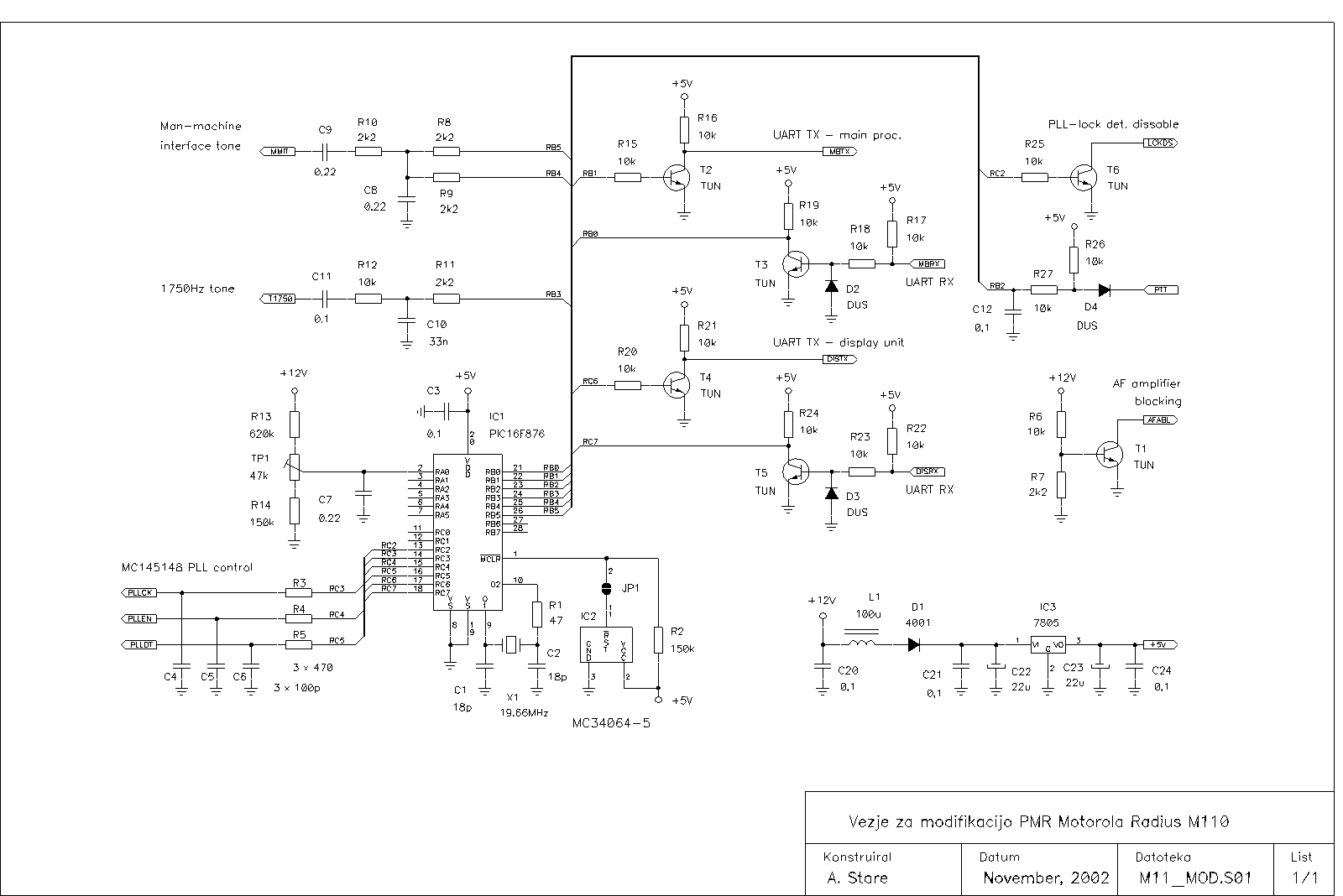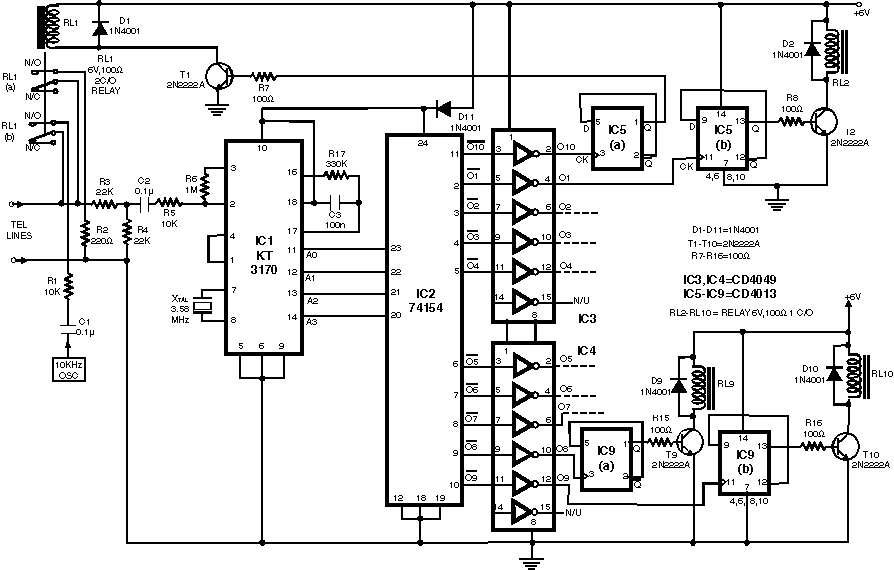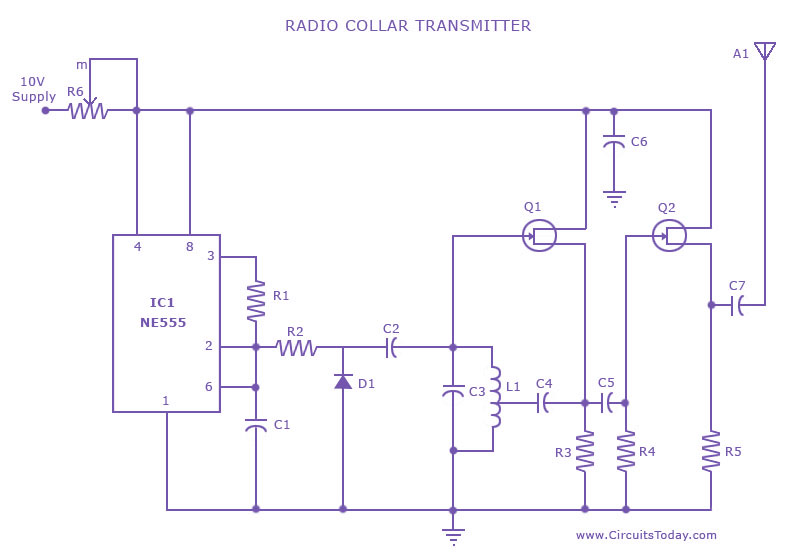
Repair Notes for Bendix Model 3TBD AM Radio
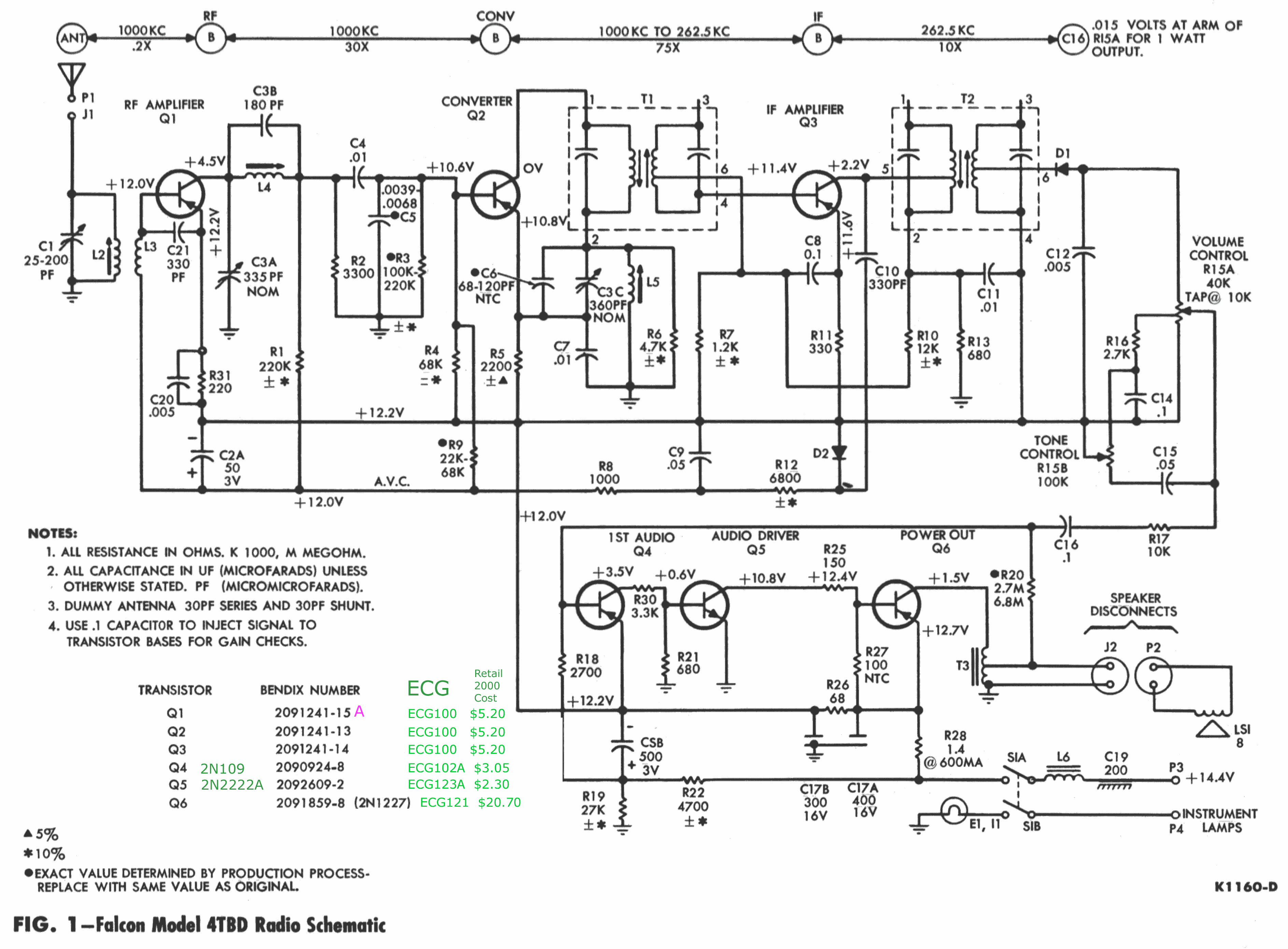
The chassis externally resembles the 22BD model, with the exception that the 22BD features a jack for speaker connections—two female sockets—located on the right (antenna) side. In contrast, the 3BTD model has a 3-inch harness (black and green wires) that exits from the left side, which is the same side as the power leads, and consists of a combined male/female connector. A good location to find the AM signal is at the connection indicated, provided that the RF, converter, and IF stages are functioning correctly. A waveform will only be observable when a station is tuned in, so monitoring the oscilloscope during tuning is essential. The first two transistors in the amplifier stage (Q4 and Q5) were removed for inspection and appeared to be functioning properly. Resistor values were also checked and found to be acceptable. After resoldering the components, the radio resumed operation. It is noted that early solid-state car radios predominantly utilized germanium transistors, with the RF amplifier, local oscillator, and converter (mixer) transistors being the most common points of failure. The collector voltages are the easiest way to diagnose a faulty transistor; a collector voltage near zero indicates an open transistor. The repair process typically involved using a meter, signal tracer, and an old signal generator, allowing for quick identification of faulty components, with over 95% of failures being attributed to open transistors. Replacement parts were generally non-critical, as components rated for RF in low ECG numbers performed adequately. Open transistors are less common in the monitors repaired, which utilize different technology and do not involve germanium parts. After two days of operation on the bench, the radio continues to function properly, but there is a plan to replace all transistors on the mainboard (Q1 through Q4) to avoid future issues, as they are likely inexpensive. Q4 (NTE/ECG102A, 2N109) is suspected to be the source of the previous problem. Q5 is a silicon component, rather than germanium, and has not been replaced. Its modern equivalent is the 2N2222, which is generally reliable unless overloaded and does not typically exhibit intermittent faults. An attempt to substitute Q2 with an NTE100 was unsuccessful; the original Q2 remains functional, indicating that the NTE "equivalent" does not suit this specific circuit.
The 3BTD model's design incorporates a unique harness configuration that distinguishes it from the 22BD model, impacting the connectivity and integration with external components. The arrangement of the connectors and the layout of the transistors within the amplifier stage are critical for the radio's performance. The RF, converter, and IF stages must be thoroughly tested to ensure that they are operational, as failure in any of these stages will prevent proper signal reception. The use of an oscilloscope during the tuning process is vital, as it allows for real-time monitoring of the signal waveform, ensuring the radio is aligned with the intended frequency.
When diagnosing issues within the amplifier stage, a systematic approach should be taken. If the collector voltage of a transistor is found to be near zero, it is essential to replace that component, as it indicates that the transistor is likely open and not functioning as intended. In many cases, the rapid identification of faulty transistors can significantly reduce repair time, allowing for efficient restoration of service.
Furthermore, the decision to replace all transistors on the mainboard as a preventive measure is a prudent strategy, especially considering the age of the components and the potential for future failures. The choice of replacement parts should take into account not only compatibility but also the performance characteristics necessary for reliable operation in the specific application.
In conclusion, the maintenance and repair of early solid-state radios, such as the 3BTD model, require a comprehensive understanding of the circuit design, component behavior, and diagnostic techniques. By adhering to best practices in component replacement and utilizing appropriate testing equipment, the longevity and functionality of these vintage devices can be preserved.Externally, the chassis looks identical to the 22BD. Exception: the 22BD has the jack for the speaker connection - two female sockets - on the right (antenna) side of the chassis; the 3BTD has a 3" harness (Black and Green wires) exiting the left side (same side as the power leads) and is a combined male/female connector. Refer to the pics I have of the earlier 22BT model. A good location to find the AM signal, is the connection shown below (if the RF/Converter/IF stages are OK). You`ll only get a waveform if you`ve tuned in a station, so watch the `scope while tuning. . . I pulled the first two transistors in the amplifier stage (Q4 & Q5) and they looked good and checked OK, checked a few resistor values, all looked OK, soldered everything `em back in and lo!
All of a sudden, it plays. I *hate* that. "Early solid state car radios used all germanium transistors. The most common failures were the RF amp, Local oscillator, and the converter (Mixer) transistors. The easiest way to find the bad transistor is to check the collector votages. If you find one that`s near zero, the transistor is open. I used to test, find the bad part and repair the radio in less time than the service clerk took to write up the work order, and all I used was a meter, signal tracer, and an old signal generator. Over 95% of the failures were open transistors, and the replacement parts weren`t critical Something rated for RF in the low ECG numbers worked very well.
" Well, open transistors are not terribly common on the monitors I`ve repaired (different tech, different era, no germanium stuff), so I am grateful for this advice from someone who`s been there. After two days` running on the bench, the radio is still running fine, but I think I`ll just replace all the transistors on the mainboard (Q1 through Q4), because I don`t want to pull this again for a while, and they`re probably cheap.
Q4 (NTE/ECG102A, 2N109) is almost certainly where the problem was. Q5 is a silicon part, not germanium, so I didn`t replace it. Its modern equivalent is a 2N2222, which is not an especially trouble-prone part unless overloaded, and certainly doesn`t go intermittent. I was unable to use the NTE100 to replace Q2; the old Q2 works OK, but subbing the NTE100 yields no output.
This must be one of those circuits in which the NTE "equivalent" isn`t. 🔗 External reference
The 3BTD model's design incorporates a unique harness configuration that distinguishes it from the 22BD model, impacting the connectivity and integration with external components. The arrangement of the connectors and the layout of the transistors within the amplifier stage are critical for the radio's performance. The RF, converter, and IF stages must be thoroughly tested to ensure that they are operational, as failure in any of these stages will prevent proper signal reception. The use of an oscilloscope during the tuning process is vital, as it allows for real-time monitoring of the signal waveform, ensuring the radio is aligned with the intended frequency.
When diagnosing issues within the amplifier stage, a systematic approach should be taken. If the collector voltage of a transistor is found to be near zero, it is essential to replace that component, as it indicates that the transistor is likely open and not functioning as intended. In many cases, the rapid identification of faulty transistors can significantly reduce repair time, allowing for efficient restoration of service.
Furthermore, the decision to replace all transistors on the mainboard as a preventive measure is a prudent strategy, especially considering the age of the components and the potential for future failures. The choice of replacement parts should take into account not only compatibility but also the performance characteristics necessary for reliable operation in the specific application.
In conclusion, the maintenance and repair of early solid-state radios, such as the 3BTD model, require a comprehensive understanding of the circuit design, component behavior, and diagnostic techniques. By adhering to best practices in component replacement and utilizing appropriate testing equipment, the longevity and functionality of these vintage devices can be preserved.Externally, the chassis looks identical to the 22BD. Exception: the 22BD has the jack for the speaker connection - two female sockets - on the right (antenna) side of the chassis; the 3BTD has a 3" harness (Black and Green wires) exiting the left side (same side as the power leads) and is a combined male/female connector. Refer to the pics I have of the earlier 22BT model. A good location to find the AM signal, is the connection shown below (if the RF/Converter/IF stages are OK). You`ll only get a waveform if you`ve tuned in a station, so watch the `scope while tuning. . . I pulled the first two transistors in the amplifier stage (Q4 & Q5) and they looked good and checked OK, checked a few resistor values, all looked OK, soldered everything `em back in and lo!
All of a sudden, it plays. I *hate* that. "Early solid state car radios used all germanium transistors. The most common failures were the RF amp, Local oscillator, and the converter (Mixer) transistors. The easiest way to find the bad transistor is to check the collector votages. If you find one that`s near zero, the transistor is open. I used to test, find the bad part and repair the radio in less time than the service clerk took to write up the work order, and all I used was a meter, signal tracer, and an old signal generator. Over 95% of the failures were open transistors, and the replacement parts weren`t critical Something rated for RF in the low ECG numbers worked very well.
" Well, open transistors are not terribly common on the monitors I`ve repaired (different tech, different era, no germanium stuff), so I am grateful for this advice from someone who`s been there. After two days` running on the bench, the radio is still running fine, but I think I`ll just replace all the transistors on the mainboard (Q1 through Q4), because I don`t want to pull this again for a while, and they`re probably cheap.
Q4 (NTE/ECG102A, 2N109) is almost certainly where the problem was. Q5 is a silicon part, not germanium, so I didn`t replace it. Its modern equivalent is a 2N2222, which is not an especially trouble-prone part unless overloaded, and certainly doesn`t go intermittent. I was unable to use the NTE100 to replace Q2; the old Q2 works OK, but subbing the NTE100 yields no output.
This must be one of those circuits in which the NTE "equivalent" isn`t. 🔗 External reference
